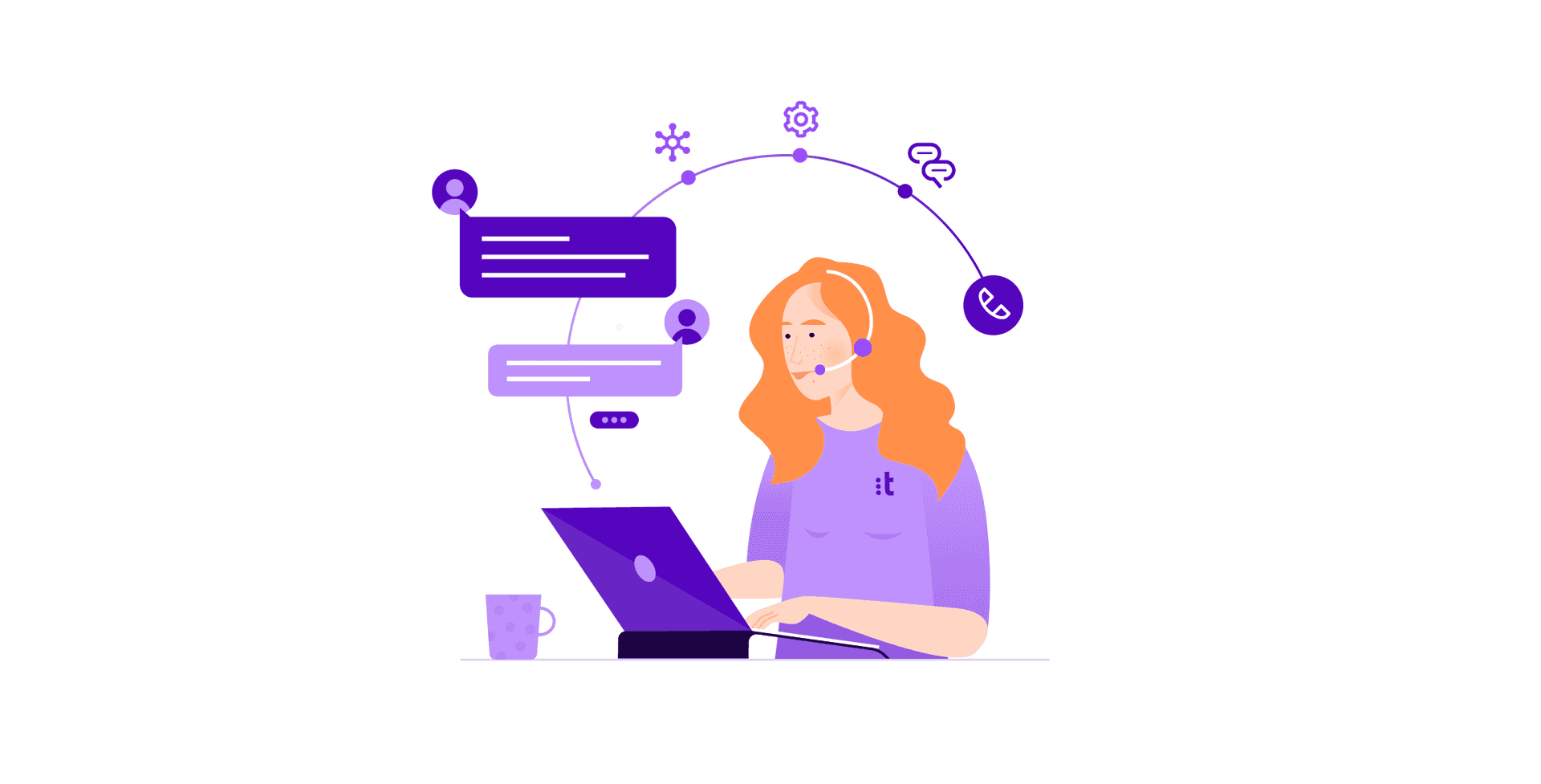What is call center software and how does it work?

By Celia Cerdeira
0 min read

Call center software plays a vital role in helping businesses manage customer interactions over the phone. Whether customers have a question about a product or a request for a refund, people who call a phone system expect that their issue will be resolved promptly and with a pleasant customer experience.
Unfortunately, too many businesses struggle with efficiently handling the volume of calls that they receive day in and day out. Agonizingly long wait times and frustrated, burned-out agents cause customers to be dissatisfied with the quality of support they receive, and the consequences can be disastrous for a business’s bottom line.
Today’s leading platforms also incorporate artificial intelligence (AI) to support agents in real time, automate repetitive tasks, and create faster, more personalized service interactions.
But what is call center software, exactly? How do call center solutions work, and how can businesses find the best call center software? We’ll answer these questions and more below in this article.
What is a call center?
A call center is a centralized environment—either physical or virtual—that manages large volumes of phone-based customer interactions. These interactions typically involve existing or prospective customers and may cover customer service, technical support, billing inquiries, sales, and more.
Historically, call centers were housed in a single location, with agents seated side by side. Today, advancements in technology have enabled virtual call centers, allowing support teams to work remotely across geographies and time zones. This distributed model helps businesses extend service availability and meet growing customer expectations for 24/7 support.
Modern call centers are also powered by VoIP (Voice over Internet Protocol) technology, which has transformed the way calls are placed and managed. Instead of relying on traditional landlines, VoIP enables agents to make and receive calls over an internet connection using cloud-based software. This helps reduce infrastructure costs and offers greater flexibility, scalability, and reliability for both in-office and remote teams.
Call center vs contact center: what’s the difference?
In modern contexts, the term call center is sometimes replaced with contact center. Although these phrases can be used interchangeably, there’s a subtle distinction between them: a contact center may include other forms of support for customers who are reaching out via multiple channels, such as email, live chat, website forms, mobile apps, or social media. This is also known as an omnichannel approach, combining multiple customer service operations and communication channels under one roof.
A call center typically focuses on voice communication, both inbound and outbound phone calls. It can be well-suited for businesses whose customer interactions are primarily handled over the phone. In contrast, a contact center expands the scope of support to include digital and asynchronous channels, enabling customers to interact with a brand on their preferred platform and at their own pace.
As customer expectations evolve, many businesses are shifting from traditional call centers to more flexible contact centers that support a seamless, omnichannel customer experience. Integrated systems, often powered by AI, allow agents to view interaction history across channels, personalize responses, and move between communication modes without disrupting the customer journey. This approach strengthens service efficiency and also improves customer loyalty.
What are the four types of call centers?
The best call center software will vary for every business. However, call centers can generally be separated into a few basic types, depending on their function. In this section, we’ll discuss four major types of call centers.
Inbound call center.
Inbound call centers handle incoming calls that originate from a customer rather than being placed by an agent. This means that inbound call centers tend to focus on customer service issues. These calls typically deal with concerns such as:
-
Product support. From help with installation and getting started to refunds and exchanges, product support is one of the essential functions of an inbound call center.
-
Order and payment processing. Call center agents can help users complete an order over the phone, as well as address issues with their billing, shipment, or payment processing.
-
Technical support. Inbound call centers can help users deal with technical issues such as lost passwords or website crashes. For advanced queries, agents may use call routing to send users to a dedicated IT support desk.
Technology for inbound call centers includes intelligent call routing software that helps direct users to the right team or department. More specifically, AI-powered routing helps reduce wait times, minimize transfers, and ensure customers are quickly connected with agents who are best equipped to resolve their issues, improving agent productivity and customer satisfaction.
Plus, with interactive voice response (IVR), an inbound call center solution can filter customers into different queues based on their specific query or problem.
Outbound call center.
Outbound call centers, by contrast, handle outgoing calls that are placed by agents rather than customers or prospective customers. As such, outbound call centers are usually staffed by business development and sales teams. These calls may deal with concerns such as:
- Sales and lead generation. Generating, developing, and qualifying leads is an essential task for many B2B companies. Many sales teams specialize in cold calling to identify the most promising opportunities and nurture them until conversion.
- Marketing research. Agents may place outbound calls to perform marketing research, such as customer surveys. Political polls are another well-known example of using outbound calls to perform research.
- Fundraising and awareness. Non-profit organizations may use an outbound call center to raise funds or awareness for a particular cause.
- Customer notifications. In some cases, a business may need to place outbound calls to notify customers about a particular issue, such as a product recall.
Modern outbound call centers rely on proactive outbound engagement technology to improve efficiency, compliance, and customer connection rates. These tools use predictive algorithms to optimize outbound dialing by identifying the best times to reach contacts and automatically filtering out unproductive calls, such as busy signals, voicemails, or disconnected numbers. More advanced systems also integrate customer data and behavioral insights to help agents tailor outreach and prioritize high-value prospects.
Blended call center.
Blended call centers handle both inbound and outbound calls. Using a blended call center can help keep agents occupied, maximize productivity, and reduce downtime. However, using a blended contact center does incur greater complexity since businesses have to use a wider range of software and technology.
The term blended call center is sometimes confused with the notion of a blended agent. Blended agents are call center employees who handle multiple forms of customer interactions and channels. Although blended agents may participate in both inbound and outbound calls, they may also handle customer interactions on channels other than phone calls, such as chats, emails, SMS messages, and social media.
Automated call center.
Today’s contact centers rely on customer service automation to manage a large volume of inbound and outbound calls.
However, the exact type and degree of automation used in an automated call center may vary widely. Some of the most popular forms of contact center automation include:
-
Automated interactions. Instead of speaking with a human agent, callers may be able to resolve their issue partially or fully by interacting with automated software. For example, automated call center software can help users leave a voicemail, find store hours or locations, or get help with other simple queries.
-
Predictions and forecasting. Being able to predict the number and types of calls in a contact center is essential to hire enough staff and efficiently handle the call volumes. Forecasting automation can help businesses better understand their historical data and make predictions, for example, how many calls agents typically receive on Thursdays.
-
Workflow management. After handling an inbound call, agents need to enter information such as the subject of the call and how the call was resolved into third-party software such as a customer relationship management (CRM) platform. Automated workflow management tools can capture and save this information, saving human agents untold hours of tedious manual effort.
-
Sales and lead generation. Beyond inbound contact centers, automated software can help outbound contact centers boost their sales and lead generation performance. For example, sales agents can create automated reminders to follow up with a promising connection or to help a new customer get started with the onboarding process.
What is call center software?
Call center software is a suite of tools designed to help customer support teams manage and streamline inbound and outbound communication, primarily by phone, but often extending to other channels, such as email. By centralizing these channels, call center software enables businesses to respond to customer inquiries more efficiently, track performance, and improve overall service quality.
While traditional platforms focused on voice operations and queue management, today’s call center software has evolved into a sophisticated ecosystem powered by AI. Some key AI-enabled use cases include:
-
Real-time insights to keep agents a step ahead. AI quickly analyzes customer data and behavior to give agents real-time context, such as likely intent, past issues, and recommended actions. This helps agents personalize conversations, reduce handling time, and deliver more efficient support.
-
Automatic summaries to reduce workload and improve accuracy. AI-generated conversation summaries eliminate the need for manual note-taking, ensuring every interaction is clearly documented and easy to follow. This saves time and helps reduce the risk of missed details or inconsistencies in follow-ups.
-
Strategic mood shift analysis for better customer insights. AI monitors customer sentiment throughout the conversation, identifying emotional shifts and what triggered them. Whether it’s a policy change, a particular tone, or an agent’s response, these insights help businesses refine their strategies to enhance satisfaction and reduce friction.
Together, these capabilities empower support teams to be more proactive, efficient, and customer-centric, making AI-powered call center software a key driver of modern customer experience strategies.
How does call center software work?
Call center software works by orchestrating a series of behind-the-scenes systems and workflows designed to manage customer interactions intelligently.
At the core, the software connects inbound and outbound calls through a cloud-based or on-premises infrastructure. These calls are routed through features like automatic call distribution (ACD) and interactive voice response (IVR), which assess caller input—either through keypresses or natural language—and direct each call to the appropriate team or agent.
The software integrates directly with tools like CRM platforms, pulling in relevant customer data before an agent even picks up the phone. This gives agents instant access to caller history, recent tickets, order status, and more, enabling faster and more personalized support.
Behind the interface, intelligent automation plays a key role. For example:
- Call queuing and routing algorithms continuously evaluate agent availability, skill level, and call priority to assign calls in real time.
- AI-powered IVR systems interpret customer intent using natural language processing, making self-service faster and more intuitive.
- Real-time dashboards and analytics help supervisors monitor performance metrics, call volume, and agent efficiency as interactions unfold.
In essence, call center software acts as both the communications engine and the operational command center, connecting customers to the right resources, surfacing relevant information for agents, and ensuring each interaction is smooth, trackable, and data-informed from start to finish.
What is inbound and outbound call center software?
Inbound and outbound contact centers may require different call center software solutions. This is because both types of call centers have separate concerns and processes that can be streamlined and optimized.
Inbound call center software typically works as follows:
-
A customer’s phone number is matched to an existing record or saved if no record exists. If the record exists, the agent is provided with information about the customer before accepting the call.
-
The call is placed in a queue based on priority and order of arrival. Agents can accept this call manually or wait for it to be assigned.
-
Once the call is complete, call center software can automatically record details about the interaction, such as the customer’s identity, length of call, topics discussed, and others, and save it to a third-party system, such as a CRM.
Outbound call center software, on the other hand, generates customer profiles for agents to call. After the call finishes, outbound call center software acts the same way as inbound call center software, recording details about the call and taking further action if necessary, for example, automatically scheduling a follow-up.
What are the benefits of call center software?
Call center software offers a range of benefits that help businesses deliver faster, smarter, and more consistent customer service. Let’s get into the specifics.
-
Faster issue resolution. Intelligent routing, CRM integrations, and real-time agent support tools help customers reach the right person quickly, reducing wait times and time-to-resolution.
-
Improved agent productivity. Automation tools like call logging and interaction summaries free agents from manual tasks so they can focus on higher-value conversations.
-
Scalable operations. Cloud-based platforms allow businesses to scale support teams up or down as needed, adapt to seasonal spikes, and support remote or hybrid workforces.
-
Enhanced customer experiences. AI-powered insights and sentiment analysis empower agents to personalize interactions and respond to customer needs with empathy and precision.
-
Centralized data and reporting. Built-in CX analytics dashboards track call volume, agent performance, customer satisfaction scores (CSAT), and more, giving leaders the insights needed to make informed decisions.
-
Better compliance and quality control. Features like call recording, audit trails, and QA monitoring help ensure regulatory compliance and maintain service standards across teams.
Get started with Talkdesk call center software today.
Call center software has evolved far beyond a tool for answering phones. It’s now a comprehensive platform that empowers agents, streamlines operations, and improves the customer experience. From intelligent call routing and real-time agent insights to AI-powered summaries and sentiment analysis, today’s solutions help businesses deliver faster, more personalized support at scale.
Here’s how two leading businesses are putting Talkdesk’s call center software into action:
-
Operating across 39 states with a network of 14,000 associates, Republic National Distributing Company (RNDC) needed to centralize its inside sales and customer care operations. By implementing Talkdesk, the company unified disparate systems and streamlined service through powerful features like inbound call routing, workforce and quality management, and Salesforce integration. The result was a 50% improvement in agent productivity and $17 million in annual cost savings.
-
Metro, a leading financial services provider in Australia, transformed its customer experience with Talkdesk by leaning into AI-powered automation. Using Talkdesk Autopilot, the company reduced manual workloads and eliminated delays tied to its legacy systems. With flexible, self-service IVR configurations and full automation of routine tasks, Metro achieved a 40% reduction in operating costs and a 100% completion rate for previously delayed tasks.
Ready to find out how Talkdesk can benefit your business? Get in touch with us today. Get a free demo of the Talkdesk CX Cloud platform.
Call center software FAQs.
Incoming and outgoing call flow is automated by call center software. IVR systems, which are common in call center software, are used to create pre-recorded greetings, menu options, and answers to frequently asked questions.
A call center is a centralized department that handles incoming and outgoing calls from current and prospective customers. Call centers are either located within a business or outsourced to another company that specializes in call handling.
Inbound call centers handle calls that come into the company. Most often, this is a service provided to existing customers of a product or service or new customers looking to make a purchase; however, it can also include providing service to a company’s employees.
An outbound call center specializes in making phone calls on your behalf and can be a low-cost option to broaden a company’s reach.
Blended call centers handle both inbound and outbound calls. Agents working in these call centers are trained to handle both types of calls.
Automated call centers use automation to handle inbound calls. Many contact centers use some degree of automation.
Call center software streamlines communication workflows, reduces manual tasks, and automates call routing, allowing agents to handle more interactions in less time. Integrated tools like real-time insights, automatic summaries, and workforce management features help teams work smarter and resolve issues faster.
Call center software is primarily focused on managing voice interactions, such as inbound and outbound phone calls. Contact center software, on the other hand, supports a broader range of communication channels—including email, live chat, SMS, and social media—for a more omnichannel customer experience.
Call center software typically uses VoIP (Voice over Internet Protocol) to manage calls over the internet, along with interactive voice response (IVR) for automated call filtering. It often integrates with CRM platforms, uses intelligent call routing to connect customers to the right agents, and may include AI features for real-time assistance and analytics.
Call center software improves customer satisfaction, boosts agent productivity, and enables more consistent service delivery. It also offers greater scalability, better reporting, and streamlined workflows, helping businesses reduce costs while enhancing the overall customer experience.





